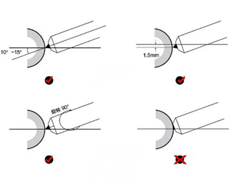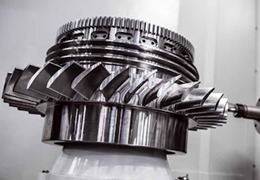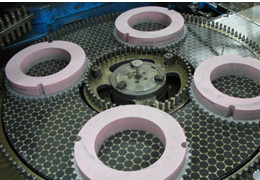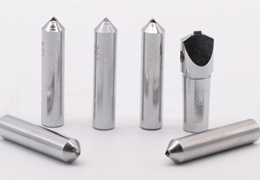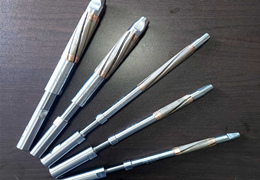The final aerodynamic performance and fatigue life of aeroengine blade are determined by the profile accuracy and surface quality. By precision milling to ensure the surface accuracy, but because of its weak rigid structure, material difficult to process, complex surface characteristics, milling surface consistency is poor, easy to form stress concentration and micro-cracks and other defects, in order to improve the surface integrity and anti-fatigue performance of grinding machining is usually used for finishing. As the final material removal process of aero-engine blade, grinding directly affects the final mechanical properties and surface state of blade. As the final material removal process of aero-engine blade, grinding directly affects the final mechanical properties and surface state of blade.
.jpg)
As the urgent demand of aviation aircraft weight loss, with high temperature nickel base alloy, titanium alloy, ceramic matrix composites as the typical representative of lightweight aircraft structure materials gradually appear, and due to its high specific strength and modulus than big, strong/toughness can good, strong high temperature stability, impact resistance and excellent mechanical properties, become the main production of hot end of aeroengine rotating component materials, It is widely used in aero-engine fans, blades and other aeronautical components with high reliability requirements.
At present, titanium alloy and nickel-based superalloy are the main materials for aeroengine. Fiber reinforced composites have excellent properties such as high temperature resistance, low density, oxidation resistance and corrosion resistance, becoming new strategic materials in the field of aviation, and gradually applied in the hot end parts of aircraft engines.
Nickel-based superalloy has excellent high temperature strength, oxidation resistance, thermal corrosion resistance and fatigue resistance, and has become a key material for manufacturing turbine blades, guide blades, turbine disks and other high temperature components of aircraft engines. Nickel-based alloy blades are mainly used in aero-engine compressor blades, which mainly work in high temperature and high pressure environment, and the service temperature is about 1000 ℃.
Because of its high strength, corrosion resistance, high temperature resistance and other advantages, titanium alloy is used in aircraft engine fan disc and blade parts, which can obviously reduce the engine mass, so as to improve the thrust-to-weight ratio of the engine. In advanced engines, the amount of titanium alloy is second only to that of high temperature alloy, accounting for 25%~40% of the total mass of the engine.
.jpg)
Titanium alloy blades are mainly used in aero-engine fan blades, and the service temperature is about 600 ℃. Compared with high temperature alloy GH2169, 600 ℃ high temperature titanium alloy has obvious advantages in specific strength, low cycle fatigue performance and fatigue crack propagation resistance in the range of 500~600 ℃.
Composite materials have been widely used in aviation manufacturing because of their mechanical properties such as high specific strength, large specific modulus and good fatigue resistance, as well as their application advantages in reducing fuel consumption and improving aircraft maneuverability. Compared with nickel base alloy, sic fiber reinforced sic ceramic matrix composites can withstand temperatures 150~200 ℃ higher, and the highest service temperature reaches 1600 ℃, and are used in turbine blades, turbine guide vanes and other hot end parts of aircraft engines.
In order to meet the requirements of blade shape, size and surface integrity, the composite component needs to be polished by grinding wheel after forming as a whole. In traditional grinding process, fiber pulling out, interface failure, matrix cracking and other damage phenomena will occur, resulting in the loss of fiber toughening effect. In addition, the fatigue defects such as microcracks are more easily formed under high temperature, high pressure and high frequency vibration service environment, which seriously reduces the service life of components.
High efficiency grinding technology is mainly divided into: Creep Feed Deep Grinding, High Speed Stroke Grinding, High Efficiency Deep Grinding, High abrasive belt Grinding Efficiency Belt Grinding.
.jpg)
Creep Feed Deep Grinding: with the increase of cutting depth, the number of abrasive particles on the surface of grinding wheel will increase simultaneously. Its advantage lies in that the grinding efficiency can be greatly improved under the condition of keeping the single grain cutting load unchanged. It has the advantages of high grinding efficiency, single grain load reduction and low grinding temperature.
High Speed Stroke Grinding: that is, the linear speed and feed speed of grinding wheel are increased, and the number of abrasive grains involved in cutting per unit time is increased. Its advantage lies in: namely obtains high efficiency and achieves high precision. It also has the advantages of small grinding force, improved grinding efficiency, improved service life of grinding wheel and low surface roughness and good surface integrity of the machined workpiece.
High Efficiency Belt Grinding: relatively oriented and reasonable arrangement of abrasives, greatly improving the static wind force of abrasives. Its advantages are: low specific grinding energy, low thermal effect, can achieve efficient operation without adding coolant.
---EDITOR: Doris Hu
---POST: Doris Hu

.jpg)
.jpg)
.jpg)
